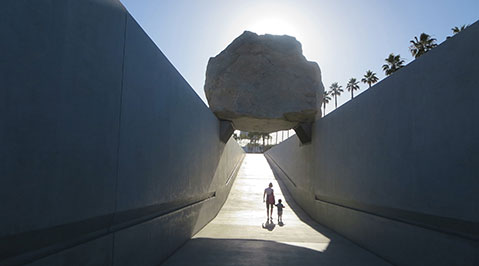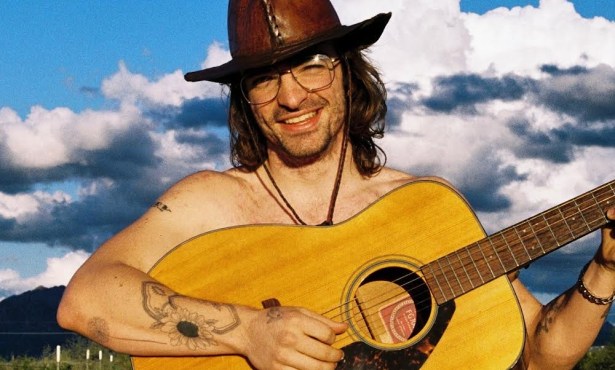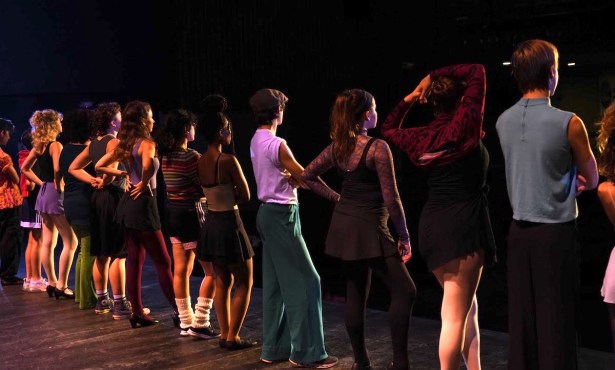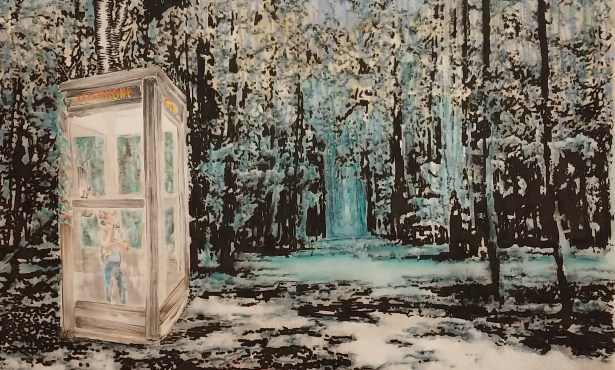A&L Presents Art on Film
Screen Series Captures Lives and Works of Four Groundbreaking Visual Artists

In a year when one of the strongest big-screen films — director Mike Leigh’s Mr. Turner, about 19th-century British painter J.M.W. Turner — was an artist biopic of the most artful order, the idea of spending hours in the dark with artist backstories may be less off-putting than usual. With UCSB Arts & Lectures’ fascinating new series of documentaries Art on Film, starting Thursday, April 21, at Campbell Hall and running for four more Thursday nights through May 12, art makes its way to the screen in humbler and also truer fashion (read: documentary fashion) and addresses its general field of interest from multiple angles.
The film sequence kicks off with Levitated Mass: The Story of Michael Heizer’s Monolithic Sculpture (April 21), directed by Doug Pray, which follows the remarkable trajectory and logistical entanglements of manifesting “land artist” Michael Heizer’s epic work of the same name at LACMA in 2012. The installation involved transporting a 340-ton boulder — a very special, mystically imbued boulder — from a Riverside County rock quarry to LACMA for one of his primal/modernist epiphanies, to the tune of $10 million.
Heizer has been focusing on land and environmental issues in his sculptures since the late ’60s, when he first attempted to create an earlier version of his 2012 piece. The film deals with the life and unique ideas of this gallery-eschewing “outsider” artist (who lives in a remote spot in Nevada and has been creating a massive land sculpture “City” for years, along with landmark works such as “Double Negative”). But the film mostly chronicles the strange creation of his LACMA work, a process that included a long account of the slow transport of “the rock” across four counties in SoCal, to the amazement, skepticism, jeers, and cheers of the public. In that way, the creation of Levitated Mass took on an uncommon public art aspect, the kinetic prelude to its ultimate sedentary state on the LACMA property, at which point the pithy Heizer said it fulfills his vision that “static art is its own language. Everything that’s said is said by it.”
For further background and contextualization of the Heizer story, proceed to James Crump’s film Troublemakers: The Story of Land Art (April 28), which makes the point that Heizer may have been the true pioneer in a the iconoclastic and site-specific medium whose most celebrated work/moment was the late Robert Smithson’s vast “Spiral Jetty,” built on the Great Salt Lake in 1970. Other artists, some included in the Earthworks exhibition in N.Y.C., included Walter de Maria, James Turrell, and Carl Andre.
And for a “straighter” artist documentary — enlivened by the delightfully eccentric life and work of its subject — Roger Sherman’s Alexander Calder (a double bill with Troublemakers) engages the senses and supplies a valuable overview of one of the 20th century’s most charmingly individual artists. The roots are traced of Calder’s childhood fascination with shapes, colors, and crafting doodads through his “wire portraits” and “cirque du Calder” performances while in Jazz Age Paris, and the eventual brainstorm of his famed “mobiles” (so named by his pal Marcel Duchamp), with gentle, loopy forms and hues inspired by Piet Mondrian and Joan Miró. By contrast, his large, abstract toy-like sculptures —“stabiles” — defied the stern, stony modernism of his sculptural day.
As art films go, especially in the carefully curated mix of this series, Finding Vivian Maier (May 5) belongs to the category of posthumous discoveries, not unlike that of superstar outsider artist Henry Darger, whose fantastical creative world spilled out of his Chicago apartment after this death. John Maloof and Charlie Siskel lead viewers into the remarkable unveiling of a true treasure trove of photographs by Maier, a nanny with an uncanny eye for photography that could have placed her among the pantheon of important fine art photographers. In the film, expert voices of Joel Meyerowitz and Mary Ellen Mark agree, and the evidence put forth on-screen persuades us of her greatness, unworthy of her obscurity.
The final film is Randall Wright’s Hockney (May 12), which tells the saga of veteran, maverick British pop artist David Hockney. Overall, the series reminds that given the inherently visual and conceptual aspects of art, especially in the contemporary realm, film can be an ideal ally in helping tell and get behind the mysterious process of making — and redefining and finding and funding and transporting — art.
4·1·1
UCSB Arts & Lectures presents Art on Film Thursdays, April 21-May 12, at 7:30 p.m. at UCSB’s Campbell Hall. Call (805) 893-3535 or see artsandlectures.sa.ucsb.edu.



